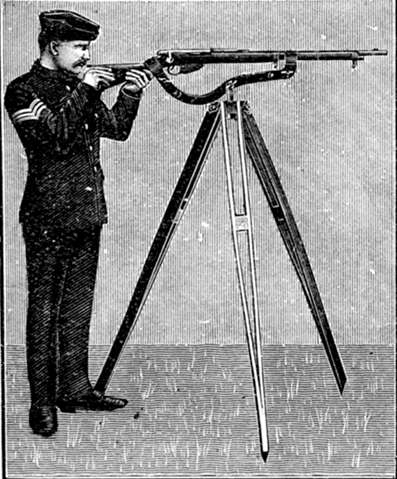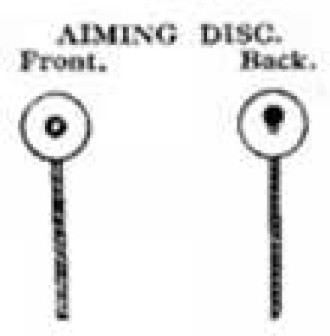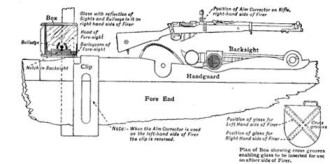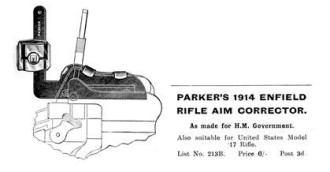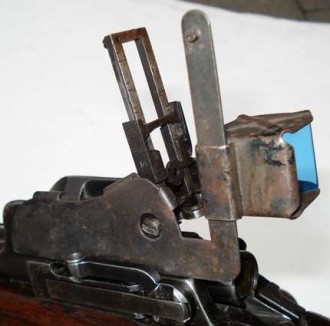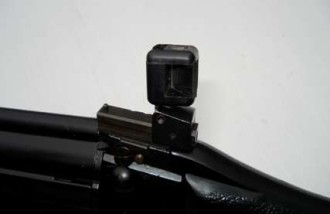By Graeme Barber
This article is in response to the February NZ Antique and Historical Arms Association eGazette and the Mystery Object contained within. With 3 members identifying the object almost simultaneously as an Aim Corrector for the SMLE and several interesting guesses the decision to write an article about the whole family of Reflective Aim Correctors seemed the right thing to do.
Following the Anglo Boer War and the perceived greater effectiveness of the Boer marksman, musketry training received a greater emphasis for infantry troops. Considerable time and effort went into the writing and refining of musketry manuals. Hand in hand with these was the development of a range of equipment to support training practices for rifles used to train British and Commonwealth recruits right through to the 1960’s.
The Aim Corrector its self was not however where the musketry training story started. This might sound a wee bit pedantic but very British reasoning required the recruit first to be taught how to aim before any aiming could be corrected. This where the A.G Parker marketed LeGret Aim Teacher adopted in LoC 15525 on 20 April 1911 as the ‘Aim Teacher Mk1” fits into the story.
Musketry instruction manuals from World War One describe the importance of the “recruit” understanding that the foresight gives direction through alignment with a definite object and that the backsight provides elevation. The effect of this was demonstrated by placing the rifle in a rest, removing the bolt and bore sighting on a target or object.
1) Engraving from a 1925 AG Parker Catalogue
2) Drawing of the Mark 1 Aiming Rest (Rifleman-UK)
3) The Legret Aim Teacher. Stamped “Made in England by A.G.P List No L.A.T.I” (Authors Collection)
The standard test for the recruit followed the instructor laying a correct aim then moving the aperture to the left. Once the rifle was moved the recruit would then lay an aim which would be checked by returning the aperture to its original position. Aims charts were used by instructors to illustrate all the stages from aligning the fore-sight to the aiming point, relating the foresight to the rear sight through to relating the foresight, backsight to the target.
4) Aims Chart (Rifleman-UK)
Once the instructor was satisfied that the recruit could correctly aim the rifle then it was taken from the aiming rest and the Reflective Aim Corrector took the place of the LeGret Aim Teacher.
Daily practice in the quest for proficiency required the recruit undertaking the following timed test
Rapid adjustment of sights (3 seconds)
Rapid loading and aiming (4 seconds)
Rapid loading, 30 drill rounds in chargers and removed from a bandolier with the pouch to be fastened after each charger load. (60 seconds)
Rapid loading aiming and firing of 10 rounds (60 seconds)
5) The recruit would aim at an Aiming Disk or object without any support. The front of the Aiming Disc was used for test 2 with the back used for test 4. (Rifleman-UK)
During this test a Reflective Aim Corrector consisting of a small metal box containing a piece of smoked glass set at 45 degrees to the barrel attached to a bar on which it can slide was attached to the rifle behind the rear sight. The glass could be placed in either of 2 slots in order to allow the instructor to position on either side of the rifle. From here the instructor could see the alignment of the sights. As the image the instructor could see was a reflection it was laterally reversed ie. if the image appeared to the left of the mark it was actually to the right of it and vice versa.
6) Drawing of an instructors sight picture through a reflective Aim Corrector (Rifleman-UK)
7) Drawing of a SMLE Aim Corrector (Rifleman-UK)
8) Aim Corrector for the S.M.L.E. (303 and .22 variants) Stamped Broad Arrow over “Foster”. (Authors Collection)
The SMLE Aim Corrector was the most abundant as evidenced by the number in collections although accurate production numbers are hard to come by. Producers were usually contractors including WW Grenner, WH Foster, T Bland, E Masson, GD Peters, Lightwood & Son, Linotype & Machinery Ltd and the Birminham Small Arms Co.
Aim Correctors were also produced for other firearms used to instruct recruits. Examples sighted thus far by the author with pictures included are for the .310 cadet, P14 (No3 Rifle), No4 and or No5 Rifle fitted with MkII rear sights and the L1A1.
9) Aim Corrector for the 310 Cadet. Stamped mark looks like 7 bullets facing the centre. (Authors Collection)
10) Sketch of an instructors sight picture through a P14 Aim Corrector (AG Parker Catalogue)
11) Aim Corrector for the P14. No visible marks on this example. (Authors Collection)
12) Aim Corrector for the No4 or No5 rifle fitted with Mk II sights. Stamped “SM II GA” over “E.M.E ‘59”. (Authors Collection)
13) Aim Corrector for the L1A1. No visible marks. (Authors Collection)
Additional information about Aim Correctors including production data would be gratefully accepted by the author.
References
Skennerton, Ian S., The Lee Enfield-A century of Lee Metford & Lee Enfield Rifles & Carbines, Ian Skennerton Publishing, Labrador, Australia, 2007
www.rifleman.org.uk/Aim_teaching_devices.
AG Parker Ltd Catalogue, 1925
Manual of Musketry, War Office, 1915
List of Changes in British War Material, various, 1910-1945
